The power of a doodle
How Tsuneo Goda and Hirokazu Minegishi went from animating NHK mascot Domo to a Sade music video

Posted: Sat May 03 2014
Let’s start at the end of the story. Tsuneo Goda, founder of award-winning dwarf animation studio in Nerima, Tokyo, has just finished working on a brand-new version of Sade’s 2000 hit single ‘By Your Side’. The animated music video (see above) was released on March 11 this year as part of the charity project Zapuni, which works to raise awareness of the children who were emotionally and psychologically traumatised by the impact of the 2011 Great Eastern Japan earthquake.
‘In the summer of 2011, we were approached by Gregory Rood, a filmmaker and artist from New Zealand who had this idea of combining the talents of Japanese anime artists with the work of international musicians with the hope of raising funds for El Sisteme [a global movement that helps heal children through music]’ explains Goda. ‘For me, living an easy life, I could not ignore the plight of those affected. I wanted to support these children who have such immense challenges to overcome, so I was happy to be involved.’
Rood got the okay from Sade, and Goda and his partner in crime Hirokazu Minegishi – who is responsible for putting Goda’s designs and storylines into stop-motion action – began work on the animation, using the lyrics ‘I’ll be there/Hold you tight to me’ as a starting point. The result is a touching stop-motion animation video that features a young girl – which Goda created based on the traditional ‘kokeshi’ (Japanese folk art dolls) – and her toy rabbit and bear companions.
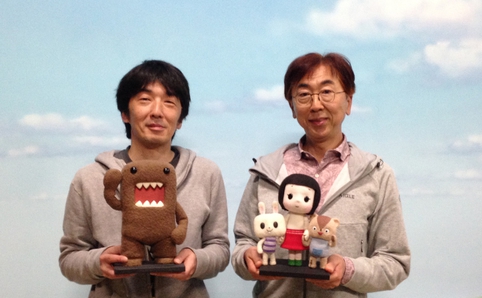 Goda (left) and Minegishi holding Domo and the characters from the 'By Your Side' music video
Goda (left) and Minegishi holding Domo and the characters from the 'By Your Side' music videoIn the world of anime, where stop motion is a thing of the past, Goda and Minegishi stand out for their preference for this painstaking form of animation. Thus far, they have achieved most of their acclaim thanks to Domo, the saw-toothed, nikujaga-eating character Goda created in 1998 for NHK. At the time Domo was created to mark NHK BS’s 10th anniversary, but he has since become the broadcaster’s official mascot, starring in his very own TV series, ‘Domo-kun’, and even spreading his wings and appearing in ad campaigns for Target and Seven-Eleven in the US. He currently has over six million likes on Facebook and he’s about to visit New York to take part in the Japan Day festival.
We sat down with Goda and Minegishi at dwarf studio to ask them more about how this unlikely little character came to life and found worldwide fame.
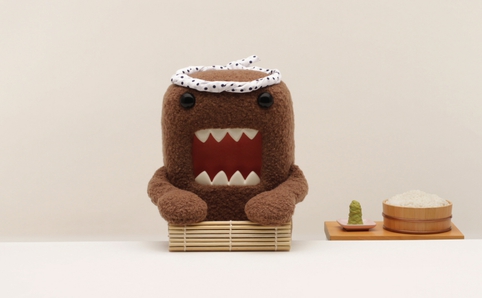 © NHK-TYO
© NHK-TYOHow did you come up with the idea for Domo?
Goda: This is something that I’m not really even sure of myself, since Domo was the first character I ever created, and I didn’t know what I was doing at first. His shape really came about just from doodling – which is how most of my ideas begin… drawing a circle, a square and a triangle. Because of this, the fact that Domo is composed of shapes that anyone could have drawn, but is still very expressive, might be part of his attraction.
But Domo can’t speak, he can only say his name, so how do you get him to express his emotions?
Goda: Luckily 'domo' has several different meanings, including ‘thank you’ and ‘sorry’, so he can express more than his name through that one word. It's a magical word. However, in order to express emotions with a character that has no eyebrows, a mouth that’s always open, no fingers and no neck, we use stuff like sweating, different eyelid movements, and reactions like surprise and sadness to create Domo-like emotions. I think that this also contributes to giving the character more of a personality.
Minegishi: From an animator’s viewpoint, ‘tools’ like sweating or blinking are very limited for expressing emotions, so I would add pauses, e.g. an action of stopping and then sweating, to create a very typically Japanese expression of failure, one that viewers would recognise. It might not be easy for foreigners to catch though.
Goda: It might be a problem if Domo starts talking. (Laughs) He would probably only say things he shouldn’t. He probably has a sharp tongue.
You must have been super surprised when Domo became famous overseas and stores like Target and Seven-Eleven (see video below) wanted to use him in their ad campaigns.
Goda: Yes, very surprised! Especially since here in Japan he wasn’t very popular at first – in fact, people thought he was a bit too scary and weird. Gradually, however, those characteristics came to be seen as funny, and Domo’s popularity started growing. People overseas somehow heard about Domo, with people online calling his TV series funny and interesting. We weren’t aware of his online popularity until around 2005/2006, when we heard about it from friends living abroad. Today Domo is very customised in America, but he is usually portrayed as a friend, which makes me very happy. One of the surprising versions is ‘Otaku-Domo’, where he wears glasses and is seen as kind of a bullied kid. This one even got printed on T-shirts, and I’ve seen people wearing them.
Why do you prefer to use stop-motion animation? It must be far more laborious than digital?
Goda: When I first came up with Domo, everything was only in picture form, but since I’m not really good at expressing things with [still] pictures, I wanted to make the character more alive. We tried things like computer-generated visuals and costumes, but when I saw Minegishi’s stop-motion work, I decided that this method would be best.
Minegishi: It takes around six cuts just to make him quickly lower his hand. And it takes around 20 cuts just for him to say ‘Domo’. One second on screen is 24 cuts. We actually only get five to six seconds of footage per day, so a 30-second clip takes five to six days to make. Sometimes it gets annoying, but I never get bored of it. (Laughs)
Besides Domo, you have created many other characters, such as the very popular Komaneko (the curious cat). Where do you get your inspiration from?
Goda: I get bored by logic, so I often just move my hands over a page, doodling and scribbling. From there, I try to look for what I can do. I also seem to have developed a strange habit of imagining a face in whatever I look at – whether it’s a flower or even a stain on a piece of clothing. I was actually worried it might be a mental problem!
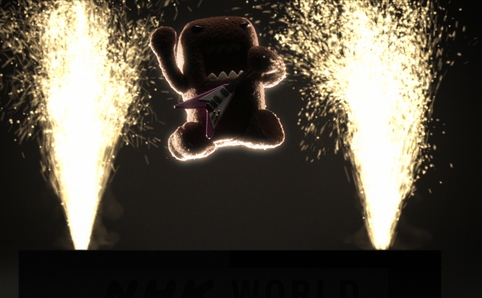 © NHK-TYO
© NHK-TYOGoda and Minegeshi will be accompanying a life-sized version of Domo to Japan Day in New York on May 11. Find out more about the event here. For more information on Domo and Dwarf animation studio, click here.
Tweets
- About Us |
- Work for Time Out |
- Send us info |
- Advertising |
- Mobile edition |
- Terms & Conditions |
- Privacy policy |
- Contact Us
Copyright © 2014 Time Out Tokyo











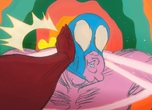
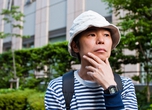

Add your comment